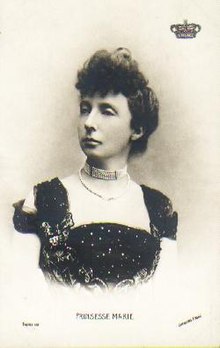Princess Marie of Orléans (1865–1909)
| Marie of Orléans | |||||||||||||||||||||||||||||||||||||||||||||||||||||||||||||||||||||||||||||||||||||||||||||||||||||||||||||||||||||||||||||||||||||||
|---|---|---|---|---|---|---|---|---|---|---|---|---|---|---|---|---|---|---|---|---|---|---|---|---|---|---|---|---|---|---|---|---|---|---|---|---|---|---|---|---|---|---|---|---|---|---|---|---|---|---|---|---|---|---|---|---|---|---|---|---|---|---|---|---|---|---|---|---|---|---|---|---|---|---|---|---|---|---|---|---|---|---|---|---|---|---|---|---|---|---|---|---|---|---|---|---|---|---|---|---|---|---|---|---|---|---|---|---|---|---|---|---|---|---|---|---|---|---|---|---|---|---|---|---|---|---|---|---|---|---|---|---|---|---|---|
| Princess Valdemar of Denmark | |||||||||||||||||||||||||||||||||||||||||||||||||||||||||||||||||||||||||||||||||||||||||||||||||||||||||||||||||||||||||||||||||||||||
 | |||||||||||||||||||||||||||||||||||||||||||||||||||||||||||||||||||||||||||||||||||||||||||||||||||||||||||||||||||||||||||||||||||||||
| Born | 13 January 1865 Ham, London, England | ||||||||||||||||||||||||||||||||||||||||||||||||||||||||||||||||||||||||||||||||||||||||||||||||||||||||||||||||||||||||||||||||||||||
| Died | 4 December 1909 (aged 44) Copenhagen, Denmark | ||||||||||||||||||||||||||||||||||||||||||||||||||||||||||||||||||||||||||||||||||||||||||||||||||||||||||||||||||||||||||||||||||||||
| Burial | |||||||||||||||||||||||||||||||||||||||||||||||||||||||||||||||||||||||||||||||||||||||||||||||||||||||||||||||||||||||||||||||||||||||
| Spouse | |||||||||||||||||||||||||||||||||||||||||||||||||||||||||||||||||||||||||||||||||||||||||||||||||||||||||||||||||||||||||||||||||||||||
| Issue | |||||||||||||||||||||||||||||||||||||||||||||||||||||||||||||||||||||||||||||||||||||||||||||||||||||||||||||||||||||||||||||||||||||||
Princess Marie of Orléans (Marie Amélie Françoise Hélène; 13 January 1865 – 4 December 1909) was a French princess by birth and a Danish princess by marriage to Prince Valdemar. She was politically active by the standards of her day. BiographyBackgroundMarie was the eldest child of François d'Orléans, prince de Joinville, and Princess Francisca of Brazil .
Born during the reign in France of her family's rival, bourgeoise".[citation needed ]
MarriageAfter obtaining arrangement usually stipulated in the marriage contract in such circumstances: sons were to be raised in the faith of their father, daughters in that of their mother.The couple took up residence at Prince George of Greece, a younger son of Valdemar's elder brother Vilhelm, who had become King of the Hellenes in 1863 as George I. The king had taken the boy to Denmark to enlist him in the Danish navy and consigned him to the care of his brother Valdemar, who was an admiral in the Danish fleet.
Feeling abandoned by his father on this occasion, George would later describe to his fiancée, Princess Marie Bonaparte, the profound attachment he developed for his uncle from that day forward.[1]
It was into this household and relationship that Marie came to live. In 1907, when George brought his bride to Bernstorff for the first family visit, Marie d'Orléans was at pains to explain to Marie Bonaparte the intimacy which united uncle and nephew, so deep that at the end of each of George's several yearly visits to Bernstorff, he would weep, Valdemar would feel ill, and the women learned to be patient and not intrude upon their husbands' private moments.[2] On this and subsequent visits, the Bonaparte princess found herself a great admirer of the Orléans princess, concluding that she was the only member of her husband's large family in Denmark and Greece endowed with brains, pluck, or character.[ George criticized Marie to his wife, alleging that she was having an affair with his uncle's stablemaster. He also contended that she drank too much alcohol and could not conceal the effects. But Marie Bonaparte found no fault with Marie d'Orléans; rather she admired her forbearance and independence under circumstances which caused her bewilderment and estrangement from her own husband.[4] Life and influenceMarie was described as impulsive, witty, and energetic, and introduced a more relaxed style to the stiff Danish court. She never fully learned to speak Danish. The marriage was friendly. She gave her children a free upbringing, and her artistic taste and Bohemian habits dominated her household. She was informal, not snobbish, believed in social equality, expressed her own opinions, and performed her ceremonial duties in an unconventional manner. In 1896, she wrote to Herman Bang: "I believe that a person, regardless of her position, should be herself".[5] She liked both to ride and to drive and was known for her elegance. She was the official protector of the fire brigade and let herself be photographed in a fire brigade uniform, which was caricatured, and as a support to her spouse's career as a marine, she had an anchor tattooed on her upper arm.[6] She once said regarding complaints about her unconventional manners: "Let them complain, I am just as happy nevertheless".[5] She had asked the permission of the court to leave the house without a lady-in-waiting, and she had mainly spent her time with artists. She painted and photographed and was a student of Otto Bache and Frants Henningsen. She participated in the exhibitions at Charlottenborg in 1889, 1901 and 1902 and was a member of the Danish Arts Academy.[5] She refused to obey the expectation on royal women to stay away from politics. In 1886, Valdemar declined the throne of Bulgaria with her consent. She belonged to the political left and participated in convincing the king to agree to the reforms of 1901, which led to an appointment of a East Asiatic Company, with contacts in his affairs in Thailand.[5] She was a popular person in Denmark.
Marie's husband and three sons were in India en route to Siam when they received word that she had died at Bernstorff.[7]
IssueThe couple had five children:
Legacy Princess Marie is commemorated with a monument at Langelinie, near St. Alban's English Church in Copenhagen. It was installed in 1912 and features a bust created by Carl Martin-Hansen.[5] Princess Marie's Home for Old Seamen and Seamen's Widows on Wildersgade in Christianshavn is named after her. Prinsesse Maries Allé in Frederiksberg is also named after her. Ancestry
ReferencesCitations
Bibliography
| |||||||||||||||||||||||||||||||||||||||||||||||||||||||||||||||||||||||||||||||||||||||||||||||||||||||||||||||||||||||||||||||||||||||

